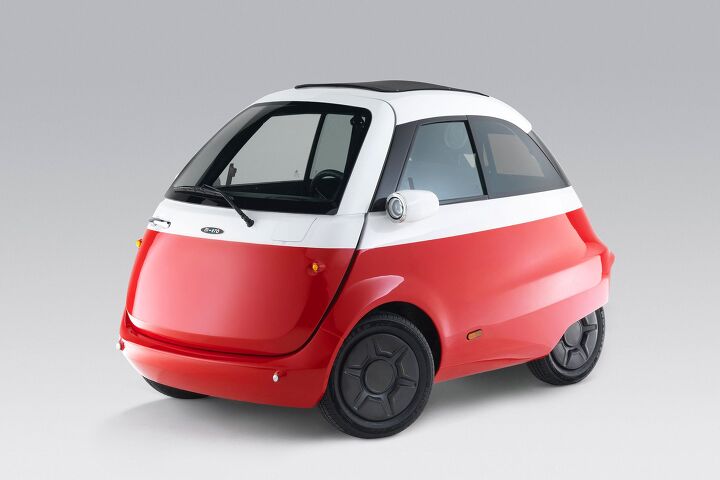The Most Interesting New Car at the Geneva Motor Show Wasn't Actually New or Technically Even a Car

Micro Mobility Systems recently strayed from producing electric scooters to build what is essentially a modern-take on the Isetta microcar called the Microlino. The Swiss firm has been bringing its enclosed quadricycle to the Geneva Motor Show since 2016, although this was the first year we’ve bothered to mention it. However, they haven’t abandoned the platform. Instead they’ve persisted, gradually approaching a point where they actually might grace public roads with the Microlino’s dainty carbon footprint.
It’s really tempting to root for little autos like this one. In addition to being adorable, they seem like the perfect solution for city dwellers who sometimes find the very idea of the traditional automobile mildly contemptible. Claims that they take up too much space or are energy inefficient can be countered with vehicles like the Microlino. Unfortunately, the odds of us ever seeing it in North America are slim.
The gumdrop-shaped transport has room for two with storage in the back for smaller items. Entry is achieved by opening the vehicles’ face, just like the classic Isetta. Bent on being a green vehicle, the Microlino uses a tiny 8.0-kWh lithium-ion battery but is still capable of an impressive 75-mile range. Shoppers can also option a 14.4-kWh unit that expands its maximum travel distance to 134 miles — more than enough for routine city use.
Micro Mobility has said the vehicle yields a of top speed of 62 mph, which is theoretically enough to take it on the highway. Although, we’d wager range becomes a bit of an issue if you have to peg the throttle in order to keep up with slow traffic. It also probably wouldn’t hold up all that well in a high-speed crash (the prototype doesn’t have seat belts but the production unit should). That might not make it a good fit for American roads but it’s hard to condemn it for that, as that wasn’t what it was built for.
It’s for parallel parking in impossibly small spaces (or just pulling in directly) and bragging to the neighbors that you have the most energy efficient vehicle in the neighborhood. We’re entering into an era where high-end manufacturers are beginning to build six-figure battery-electric sport utility vehicles. These faux-green models are truly magnificent but they also betray the whole point of moving toward electrification in the first place. They aren’t hyper-efficient eco cars for the masses — but the Microlino is. You could own one of these babies and be as comfortably smug as a Prius owner from 2004.
It’s what the world claimed it wanted when this obsession with electrification began and it is cutesy and efficient enough for skeptics to buy into it. So why won’t it sell in America? Safety issues are the biggest hurdle to get around. While it wouldn’t be marketed as a car, it still might get hit with regulatory hurdles it couldn’t possibly overcome. Average American’s also have a more-than-mild aversion to microcars.
Pricing is also an issue. Micro Mobility has said it would probably cost at least €10,000 (or about $12,500). In the United States, you could could negotiate a Chevrolet Spark for that price. Still, the company has said it’s acquired several thousand preorders already. All it has to do now is avoid becoming the European equivalent of Elio Motors. Fortunately, things appear to be more-or-less on track for Micro Mobility and the company has said production of the goofy little non-car will begin later this year.
[Images: Micro Mobility Systems]

A staunch consumer advocate tracking industry trends and regulation. Before joining TTAC, Matt spent a decade working for marketing and research firms based in NYC. Clients included several of the world’s largest automakers, global tire brands, and aftermarket part suppliers. Dissatisfied with the corporate world and resentful of having to wear suits everyday, he pivoted to writing about cars. Since then, that man has become an ardent supporter of the right-to-repair movement, been interviewed on the auto industry by national radio broadcasts, driven more rental cars than anyone ever should, participated in amateur rallying events, and received the requisite minimum training as sanctioned by the SCCA. Handy with a wrench, Matt grew up surrounded by Detroit auto workers and managed to get a pizza delivery job before he was legally eligible. He later found himself driving box trucks through Manhattan, guaranteeing future sympathy for actual truckers. He continues to conduct research pertaining to the automotive sector as an independent contractor and has since moved back to his native Michigan, closer to where the cars are born. A contrarian, Matt claims to prefer understeer — stating that front and all-wheel drive vehicles cater best to his driving style.
More by Matt Posky
Latest Car Reviews
Read moreLatest Product Reviews
Read moreRecent Comments
- Doc423 SDC's are still a LONG way off, 15-20 years minimum.
- CanadaCraig Luke24. You didn't answer MY question.
- Jeff I have never bought summer tires just all season and sometimes snow tires. Up until the last few years I had 2 midsize trucks which had 15 inch tires and when I got tires the last time for both I had a choice of just 2 tires Goodyear and Hankook all season tires. Hard to get any tires size 15 and below
- MaintenanceCosts This is probably as good as B5.5's get, but keeping it that way is going to be very very expensive, and for all that money you won't even have three pedals.
- Urlik Peak Passat.





































Comments
Join the conversation
Still too space-inefficient for everyone to use it in big cities. The only powered vehicle that really works in a city if you assume that everyone will use one is a scooter, moped, or very small motorcycle.
Can't see how this could be marketed as a car legally, but hey, I like the idea :)